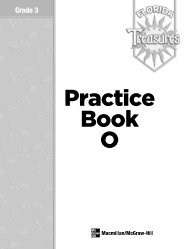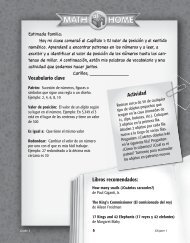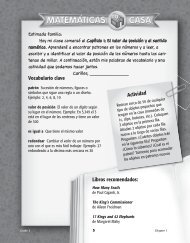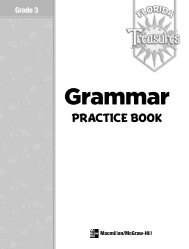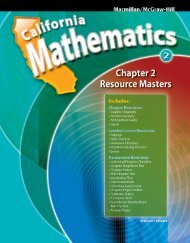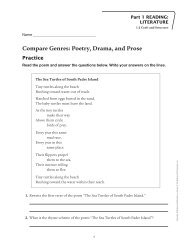Practice - Macmillan/McGraw-Hill
Practice - Macmillan/McGraw-Hill
Practice - Macmillan/McGraw-Hill
You also want an ePaper? Increase the reach of your titles
YUMPU automatically turns print PDFs into web optimized ePapers that Google loves.
Name<br />
A process diagram is a drawing that shows how something is<br />
put together, how something works, or how something changes<br />
over time. In a diagram, the important parts of an object are<br />
labeled.<br />
Below is a diagram of the water cycle. Use it to answer the<br />
questions.<br />
2. Condensation: The<br />
water vapor rises, forms<br />
clouds, and is cooled by<br />
the air.<br />
1. Evaporation: The sun heats<br />
water in the soil, rivers,<br />
lakes, and oceans. The<br />
water evaporates and turns<br />
into water vapor, a gas.<br />
1. What are two forms of precipitation?<br />
2. What is the gas that results from evaporation called?<br />
3. What does the water vapor form during condensation?<br />
4. Where does water go when it falls back to Earth as precipitation?<br />
5. What source of energy drives the water cycle?<br />
6. What causes water to change from clouds into precipitation?<br />
100<br />
My Great-Grandmother’s Gourd<br />
Grade 5/Unit 3<br />
<strong>Practice</strong><br />
Text Feature:<br />
Process Diagram<br />
3. Precipitation: Water<br />
returns to Earth as<br />
rain, snow, or other<br />
precipitation. Some water<br />
seeps into the ground.<br />
Some water returns to<br />
the ocean.<br />
At Home: Find a process diagram in a magazine or<br />
newspaper. Then explain the diagram to a family member or<br />
helper.<br />
© <strong>Macmillan</strong>/<strong>McGraw</strong>-<strong>Hill</strong>



